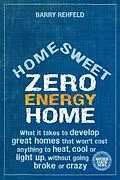Zero energy homes produce at least as much energy as they consume through a combination of energy efficiencies, passive design and renewable energy production. California has adopted zero net energy as the new residential standard for 2020; many other governments are considering similar policies. Developing zero energy homes is the first step towards making all buildings zero energy - a critical step in mitigating climate change, since buildings account for 40% of material and energy use worldwide.
Home Sweet Zero Energy Home is the first practical guidebook that clearly shows how zero energy homes can be good, livable, affordable homes. The author identifies all the pieces of the zero energy puzzle and how they fallinto place, and explains how homeowners and buyers can also take smaller steps towards sharply reducing the energy use of existing buildings. Focusing on real costs and savings, this book takes an in depth look at:
- Site selection and passive design
- Insulation, windows, doors and building materials
- Heating and cooling
- Appliances and electronics
- Financial resources and incentives.
Whether you are a prospective buyer, owner, or developer, Home Sweet Zero Energy Home is your complete guide to creating a more comfortable, efficient, environmentally friendly home without breaking your back or yourbank account.
Autorentext
Barry Rehfeldhas been a journalist for over 30 years and is the founder of zeroenergyintelligence.com where he writes about everything you need to know to build, buy or renovate a home that produces as much energy as it uses.
Inhalt
1. Free and Clear
An introductory look (*see chapter below*) into the promise of developing bright, affordable homes with no gas and electric bills to pay and that are incredibly comfortable, quiet, efficient, safe and good for the health oftheir occupants and the planet.
2. Following the Sun
While it may seem to be just sitting there like any other house, the zero
energy home is hard at work helping you to reach your goal - if it's designed right.
3. Finding the Dream Builder
Finding someone who can develop a zero energy home may be the biggest challenge. Virtually no builder has a track record of building single-familyzero energy grid-connected homes for middle class buyers and homeowners who have been freed from paying utility bills.
4. Best Bang for the Bucks
Insulation is arguably the most important part of a zero energy home. Thebest of it will give the house its biggest boost towards reaching zeroenergy at the lowest cost. In fact, there is no compromise here. It's the deal maker or breaker in most parts of the country.
It may not get sorted out to everyone's satisfaction because there is some controversy about insulation. The best of it leads to a clash between energy efficiency and sustainability. I show how.
5. Taking a Good Look
How much space is devoted to windows is only the beginning of deciding what works and what doesn't with windows. These are not your grandma's windows and they have a story of their own to tell.
for anyone developing a zero energy home. I'll tell the reader what it isand why.
6. The Financial Edges
You don't have to go it alone in financing a zero energy home. Federal, state and local government, utilities, private investors and banks can provide tax benefits, reasonable loans and, in some cases, five-figure rebates.
7. All America All-Electric
It can be heated with a hair dryer is a boast associated with builders and owners of super insulated homes. While a bit of a stretch, the point is well taken. That big only gas-fired tank in the basement favored by a clear majority of Americans is or should be history.
8. Getting Into Hot Water
A no-brainer in developing a zero energy house is getting rid of the 24/7energy guzzling hot water storage tank or relegating its role to back-upstatus. The more difficult question is what its replacement should be.
9. The Right Stuff
The big energy-savings decisions are done with. Now you face many smaller ones. No sweat. You just need to add a budget-minded Energy Star savvy gate keeper before letting a dishwasher, a clothes washer/dryer, a refrigerator and other energy users through your door.
A. Refrigerator
B. Washer/Dryers
C. Dishwasher
D. Lighting
10. Sustaining the Drive
A zero energy home can be a sustainable one too. It can be costly though, so something will have to give. In this chapter, I write about a number of
other features found in any house where you can hoist yourself on the horns
of this dilemma.
11. The Growing Electric Appetite
With each passing year the number of appliances, devices and gadgets running on electricity keeps growing. The worst gluttons have screens: televisions and computers along with their various attachments.
I'll look in the issue of behavior modification because energy savings are being offset by new energy use.
12. Under Its Own Power
In one sense the single-family zero energy home is a secret weapon in the battle against global warming and just what it is can be summed up in two words: real estate.
In the course of telling this story, I write about how solar thermal, wind and other renewable energy sources may or may not fit in the zero energy home picture.
13. Setting a New Standard
Californian Larry Schlussler knows he has a zero energy home. The bill from the utility company comes in every month with no charges on it. However, ifyou're building a zero energy home and want or need to get some idea that you will actually make it, you can get it rated in advance.
